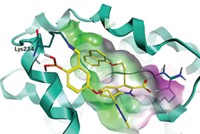Advertisement
Grab your lab coat. Let's get started
Welcome!
Welcome!
Create an account below to get 6 C&EN articles per month, receive newsletters and more - all free.
It seems this is your first time logging in online. Please enter the following information to continue.
As an ACS member you automatically get access to this site. All we need is few more details to create your reading experience.
Not you? Sign in with a different account.
Not you? Sign in with a different account.
ERROR 1
ERROR 1
ERROR 2
ERROR 2
ERROR 2
ERROR 2
ERROR 2
Password and Confirm password must match.
If you have an ACS member number, please enter it here so we can link this account to your membership. (optional)
ERROR 2
ACS values your privacy. By submitting your information, you are gaining access to C&EN and subscribing to our weekly newsletter. We use the information you provide to make your reading experience better, and we will never sell your data to third party members.
Drug Discovery
Membrane proteins open door into the cell for large bivalent molecules
Researchers report entry path for molecules once thought too big to be drugs
by Laurel Oldach
December 19, 2022
The upper size limit on cell-penetrating drug molecules may be much higher than medicinal chemists had thought. A research team reports that molecules believed to be much too large to diffuse across the cell membrane can enter with help from a family of membrane proteins (Science 2022, DOI: 10.1126/science.abl5829). The researchers say the work may open new chemical space for drugging challenging targets.
Medicinal chemists use rules of thumb that consider size, polarity, and other attributes to predict whether a new molecule will behave like a drug. These rules “help you stay in the right sandbox,” says coauthor Kevan Shokat of the University of California, San Francisco. “But sometimes you really need to go outside of that to generate some new functionality.”

For example, in 2016, Shokat’s lab designed an unusually large inhibitor of the kinase mTOR, which governs cell growth and is often overactive in cancer. The molecule is part of a fast-growing class of bivalent drugs, which have two biologically active warheads connected by an inert linker. Some, such as proteolysis-targeting chimeras (PROTACs), work by bringing two molecules together. Others, known more specifically as bitopic drugs, bind two target sites on a single protein to boost potency, such as the mTOR inhibitor, which is built from two weaker inhibitors. To reach both sites at once, the bitopic mTOR inhibitor needed an unusually long flexible linker. At a molecular mass of roughly 1,800 Da, it appears too large to diffuse into cells according to known rules of thumb.
To learn more, researchers in Shokat’s and UCSF coauthor Luke Gilbert’s labs used CRISPR to upregulate and downregulate each gene in a human cell line and identify proteins that affect response to the bitopic inhibitor but not to its individual components. They found that a family of proteins called interferon-induced transmembrane proteins (IFITMs) facilitate the drug’s entry into cells.
The researchers then constructed two novel bitopic inhibitors with long linkers, tested their ability to get into cells, and found that these molecules also rely on IFITMs. In contrast, smaller bivalent molecules, such as PROTACs, do not need IFITMs, though they may enter cells more quickly when an IFITM is present.
How IFITMs help the molecule across the membrane joins a list of unanswered questions about the proteins, which also affect viral invasion. According to Richard Sloan, a virologist at the University of Edinburgh, biologists suspect that the proteins alter membrane curvature or fluidity, which might also affect drug diffusion or endocytosis.
“People, in my opinion, have shied away from creating bitopic or bivalent inhibitors that have long linkers,” Gilbert says. He hopes that this study will inspire the same kind of excitement over long-linker drugs as has been seen for smaller bivalent molecules.





Join the conversation
Contact the reporter
Submit a Letter to the Editor for publication
Engage with us on Twitter